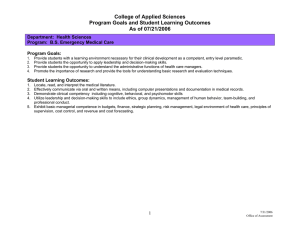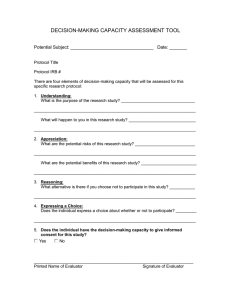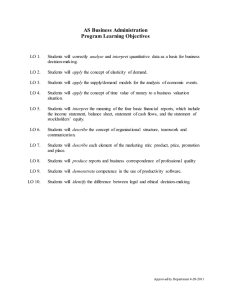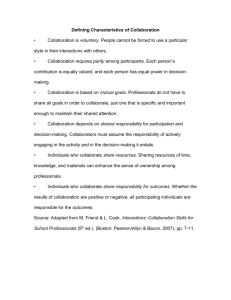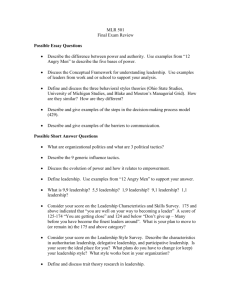Interpersonal and Communication Skills Information Sharing
advertisement
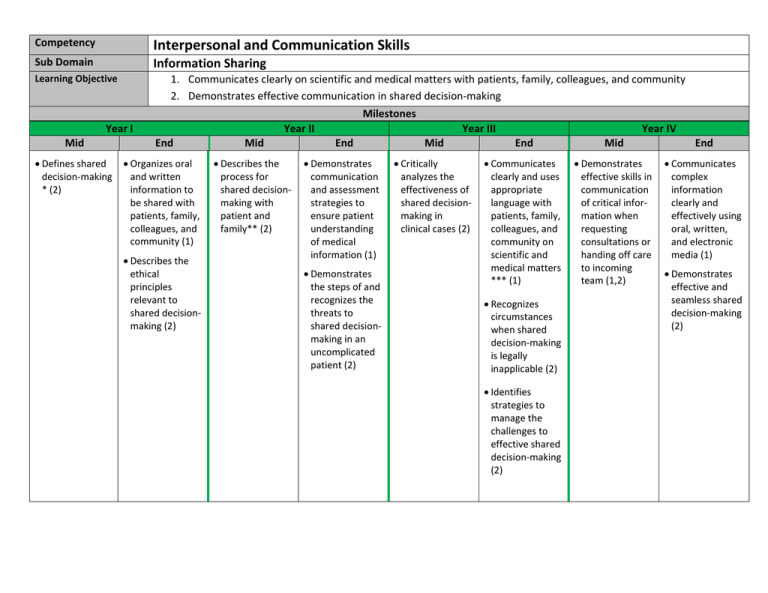
Interpersonal and Communication Skills Competency Information Sharing Sub Domain Learning Objective Mid 1. Communicates clearly on scientific and medical matters with patients, family, colleagues, and community 2. Demonstrates effective communication in shared decision-making Year I • Defines shared decision-making * (2) Year II End Mid • Organizes oral and written information to be shared with patients, family, colleagues, and community (1) • Describes the process for shared decisionmaking with patient and family** (2) • Describes the ethical principles relevant to shared decisionmaking (2) Milestones Year III End Mid • Demonstrates communication and assessment strategies to ensure patient understanding of medical information (1) • Critically analyzes the effectiveness of shared decisionmaking in clinical cases (2) • Demonstrates the steps of and recognizes the threats to shared decisionmaking in an uncomplicated patient (2) Year IV End Mid • Communicates clearly and uses appropriate language with patients, family, colleagues, and community on scientific and medical matters *** (1) • Demonstrates effective skills in communication of critical information when requesting consultations or handing off care to incoming team (1,2) • Recognizes circumstances when shared decision-making is legally inapplicable (2) • Identifies strategies to manage the challenges to effective shared decision-making (2) End • Communicates complex information clearly and effectively using oral, written, and electronic media (1) • Demonstrates effective and seamless shared decision-making (2) APPENDIX * Shared Decision-Making Definition: Decisions made through collaboration between patients and their doctors, informed by the best evidence and resources available, and weighed according to the specific characteristics and values of the patient. The positive outcomes of shared decision-making are not only in the decision but also in the therapeutic relationship and include increased understanding of values, priorities, and perspectives. ** Process of Shared Decision-Making • • • • • Determine stakeholders (i.e. patient, providers, treatment team, self, society) of the decision Determine evidence for treatment and relevant resources Inquire patient’s opinions, concerns, goals, and priorities Share one’s professional assessment, concerns, goals, priorities in light of patient’s perspectives Actively elicit patient (and/or other stakeholders) opinions/concerns/goals/priorities *** Scientific matters can be communicated clearly to patients and the public, taking into account the level of scientific literacy of the audiences and understanding the intellectual and emotional responses to medical diagnoses and therapies (adapted from: AAMC-HHMI Scientific Foundations for Future Physicians, 2009). For example, physicians should be able to explain to patients: • the complexity and variability of the human body to help them appreciate that there is no single approach to the prevention, diagnosis, and management of disease; • the influence of genetic, lifestyle (behavioral, psychological, sociocultural), and environmental factors in health and disease, as well as the heritability of genetic factors; • in appropriate terms, the technologies for diagnosis and treatment of disease, their relative risks and benefits, and the advantages and disadvantages of alternative choices; • in appropriate terms, the rationale for treatment strategies, including lifestyle changes as well as pharmacological interventions, how the drugs work, their possible interactions with other drugs, their risks and benefits, and alternatives, both pharmacological and non-pharmacological; and • how the brain and other organ systems interact to mediate behavior throughout the lifespan in health and in disease.

